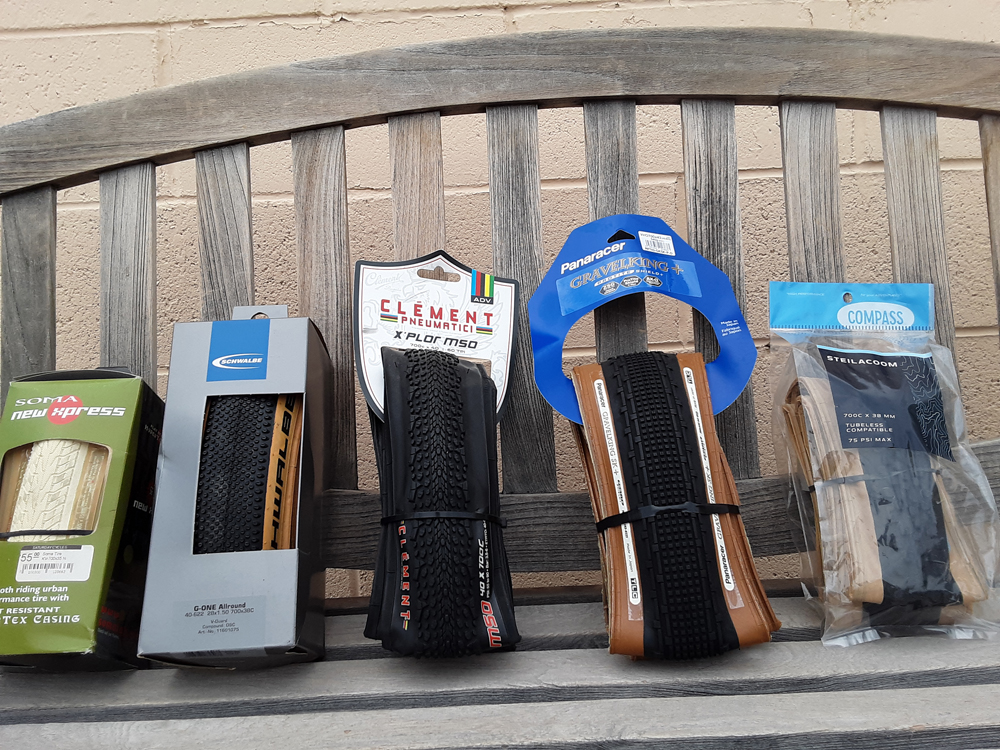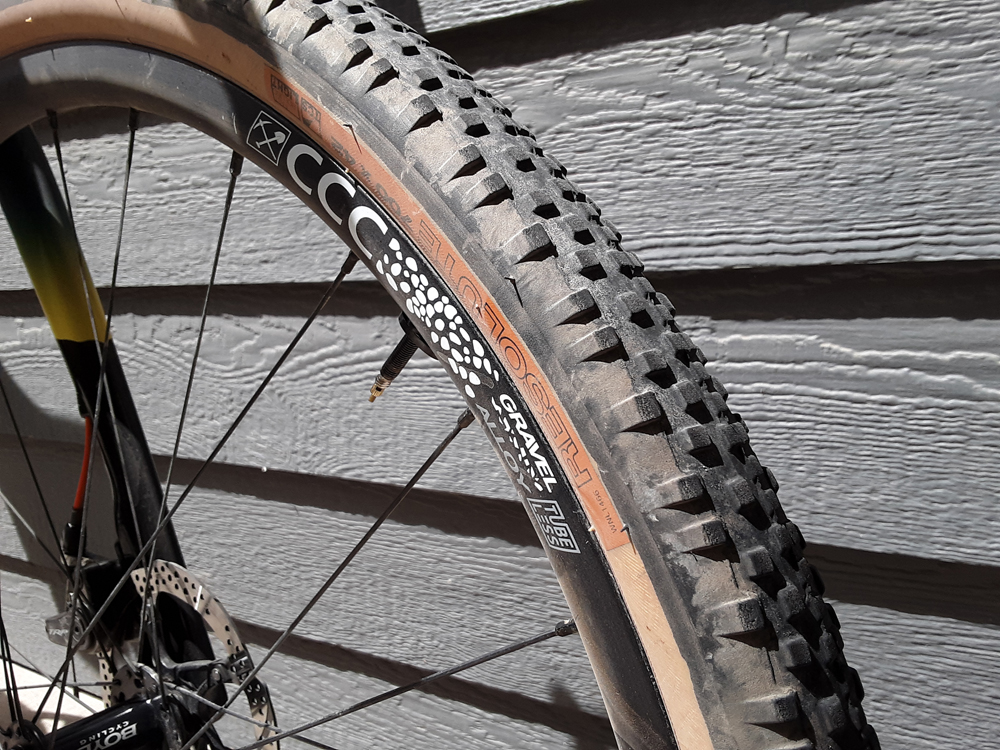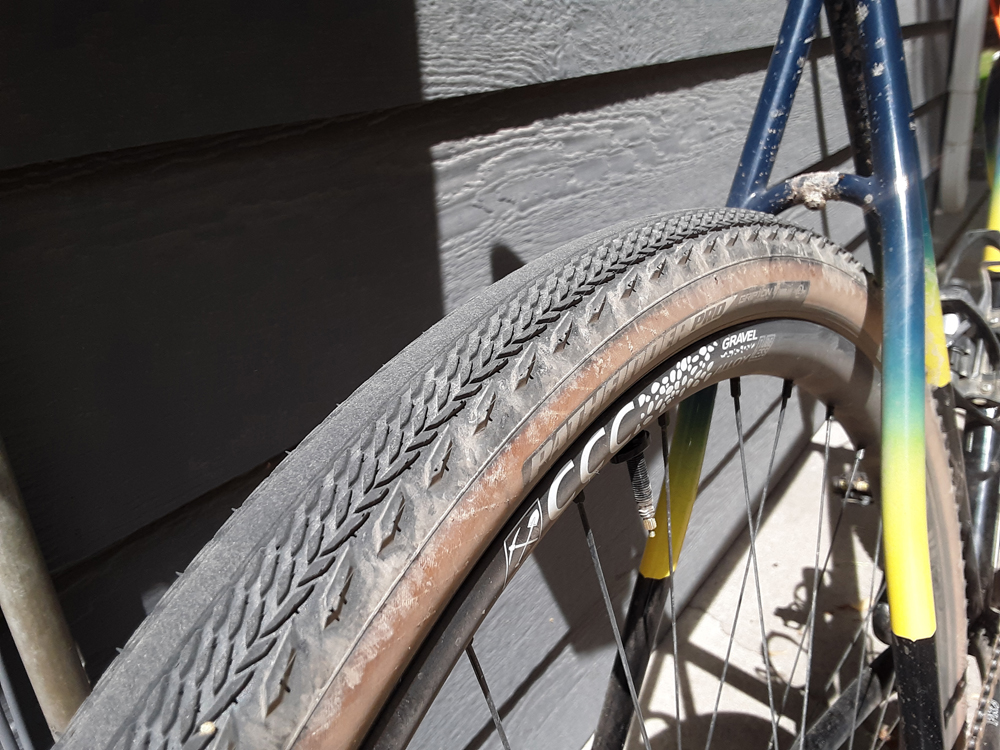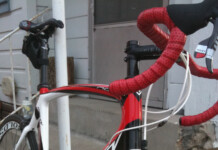By Bobby Kennedy — Now that the gravel calendar is blooming like myrtle spurge, it’s time to talk tires.
Why now? Because I get asked about tires, and ask others for recommendations about tires, more than any other subject by an absolutely enormous margin. They make more difference to your ride than nearly any other component on the bike, possibly barring the saddle. Tires can make or break your ride but using the right tire for every ride potentially means having several dozen sets all queued up and ready to go, which means no, no way in hell. Especially not if you’re running without tubes.

So there’s no better time to figure out what kinds of tires are best for you and your ride, or to figure out whether angels have navels, or if that one-handed clap you can kind of do counts, or if trees only fall in the presence of an observer than right now, when we’re basically barred from all the productive things that would otherwise call us back to sanity.
Ground rules: this is not a tire review. This is a theoretical treatise on tire selection theory. If you aren’t sitting down, get on that. The largest bike parts distributer in the US, Quality Bicycle Products, lists over 1500 models of tire in its inventory. Not all of those are for gravel, but a lot are. And QBP doesn’t carry a lot of brands, or even all the gravel tires produced by the brands that they do carry. So yeah, we’re going to stay general. Hopefully, after you read this, you can help someone else find their tires rather than being the nth person to ask, “What tire should I run for ______?” We’re going to talk about design rather than model.
But what makes for a good gravel tire? Gravel is weird because the surfaces are often worse than you’d find on dedicated mountain bike trails, but the tires need to roll fast and (usually) fit into frames that won’t accommodate tires larger than 42mm (this is changing, but 42mm is pretty common). So out-and-out mountain bike tires won’t fit. To make it more difficult, most people tend to ride decent amounts of pavement on their gravel bike, so tires should be fast, too. There are a few different kinds of gravel tires and they basically fit into one of these three categories: hardpack, hardpack with knobs, full-on knobbies. So, God help us, let’s begin.
First Thing: Bigger is Almost Always Better
No matter what kind of tire you run, bigger tires will give you better traction, comfort, and float than smaller sizes of the same tire. There are limits. A big tire can still ride like a rock if it has a full puncture belt and you pump it up to 1000 PSI. But, unlike on asphalt, where efficiency is king, traction and comfort are what make you fast on dirt and gravel. Bigger tires are also heavier, usually, so there’s that, but even a little higher weight often won’t overcome the benefits of being able to float over loose surfaces. I got dropped on my own Salty Lizard 100 course by a bunch of guys on mountain bikes because we rode on a ton of sand that my 700c x 40 tires wouldn’t let me drift over like their 29 x 2.3” tires let them. Longer courses, too, usually favor big, comfy tires – not a lot of 40 mm tires on the Tour Divide. But, on the other hand, if you need a good tire for the Crusher in the Tushar, weight and efficiency become important again: no one wants to lug 4 lbs. (roughly two light 29” tires) up the Col de Crush. So yeah, whatever else you read below, remember that bigger is almost always better except when you’re about to climb 10k’ in a competitive setting.
Supple As Flip: Hardpack Tires
Hardpack tires – the Panaracer Gravelking, Hutchinson Sector, Maxxis Refuse – rely on teeny treads, volume, soft rubber, and suppleness to keep you anchored to pavement and hardpack dirt. That tread might be siping (Gravelking and Sector) which looks like wee little ridges, or a file tread (Challenge Gravel Tire, Maxxis Refuse, and IRC Boken), which looks like lots of dots or tiny diamonds. Some, like Vittoria’s Terreno Dry, rely on space-age materials that I’m just flat not qualified to discuss. Hardpack tires roll really fast on those miniscule treads, basically like road tires. The tiny treads hook up just enough with nearly-solid surfaces to keep you from skittering all over the place, while the suppleness (just a minute on that one) of the tire helps it to deform around the road surface and keep those treads pressed firmly into the terra. None of these are industry terms, btw. I’m just demystifying marketing here.
Anyway.
Suppleness is the quasi-sexual term for how much and how readily the tire deforms under pressure. Tires with a thin carcass (rubber outside) and cap (rubber on the top) tend to be pretty supple because there’s not much material to deform in the first place. That can be awesome. Supple tires tend to be more comfortable at a given size and pressure than non-supple tires. They also have a built-in puncture-resistance because they’ll deform over a sharp thing rather than resist it and get stuck. Think of trying to poke a hole in a piece of paper that’s pulled taught versus one that’s just kind of floating loose. They can also be very, very fast because that comfort and ability to deform means that you can just chug on through whatever you hit.
But being supple and having tiny treads alone won’t keep you on the ground, so many truly hardpack tires often have a fairly soft rubber compound as well. This is definitely the case with the Boken, not so much with the Sector. The official term here is “durometer,” the relative hardness of the material itself. Soft, low-durometer compounds deform and grip more easily and can rebound more comfortably than harder durometer compounds, but they also wear faster and break easier.
So, the skinny on these tires is that they’ll generally handle asphalt and asphalt-like surfaces just fine, but they might explode when exposed to rocks. That depends heavily on the compound and whether the company has added a puncture-resistant belt, but the trade-off there is that the belt generally decreases the ability of the tire to deform and thus, its beautiful suppleness. These tires are generally very round as well since they don’t have shoulder knobs, which is great for cornering on hard surfaces, not so hot at digging into sand. However, that roundness can make them absolutely amazing at surfing through deep, fresh gravel. Really, it’s beautiful. Everyone should experience it at least once.
Send It: Knobbies
Knobby tires sit on the far side of the spectrum. They tend to feature large knobs on top and shoulder knobs that are meant to bite into softer surfaces. That’s the secret of knobbies: they bite into things that are softer than the knob material. When they bite, you have great traction and you can rail things that would wipe out riders on slicks. But on pavement, which is way harder than the tire material, your knobs are useless. This is why even knobby tires generally have a round silhouette: they have to maintain some kind of even traction on pavement. Squared-off profiles might bite well in soft conditions but when you get back on hardpack, they’ll try to lose grip when you lean the tire over the corner of the profile. My WTB Resolutes are very much knobby tires, but the knobs are arranged so that looking at them, they appear to have a solidly round silhouette. The Resolute is pretty sweet.

And they bring up a good point about those knobs. In front tires, knobs are pretty great. You can lean the bike over into turns and not loose traction because when the rear wheel goes out from under you, you can recover, but if the front goes, the only place you’re going is over the bars. In the rear, those knobs can help you grip on loose climbs, but they tend to interfere with your efficiency and traction everywhere else. In the rear, the knobs on a Resolute squirm under rider weight/power. So instead of that planted feeling of a tire holding on for dear life, you get a feeling like pulling Velcro. Braking, that interrupted surface between knobs doesn’t grip as well as a slick or semi-slick because, well, there’s nothing there. The knob might grip, but it can’t bite, and its effective edge (the bit that works on the ground) is smaller than the smooth surface of a slick, or the center line of a semi-slick.
In general, the best things to think about with knobs are: how tall and how many? Widely spaced knobs can get you better traction in very loose conditions like sand and mud, where you need to be able to get rid of material as you move. Same with tall knobs, which bite deeper into the nasty stuff but will squirm more on hard surfaces. Closely-spaced low knobs, like on the Maxxis Rambler or Panaracer’s own ticket to tire immortality, the Gravelking SK, will roll and grip better on hardpack but can leave you washing out when you’re caught in the sand trap. So, it’s a question of what you think you’re going to end up on: the faster you think you’re going to be travelling on really crappy surfaces, the more and taller knobs you need. As a bonus, knobby tires often come with extra protection, though some, like the Resolute, just come with sidewall protection and depend on tubeless tire sealant and the knobs themselves to prevent punctures. In the latter case, knobby tires can sometimes be actually lighter than semi-slicks and slicks, which have a continuously thick carcass around the whole tire. I’m running a Resolute in the front and a Specialized Pathfinder semi-slick in the rear that outweighs it by at least 40 g despite being the same labelled size. So why would I want to run it, when I don’t have as much grip on dirt as with another Resolute or as much grip on pavement as with a slick? Well…

Semi-slick Tires
Some tires try to split the difference between a pavement tire and a knobby by combining both into one tire. Semi-slicks often have some kind of transition and shoulder knob but a fairly continuous and fairly smooth centerline that’s supposed to give you the efficiency on the road of a slick. They can be more or less continuous or smooth. The Specialized Pathfinder is a peaky (triangular-silhouetted) semi-slick with a perfectly smooth centerline and lots of finger-like transition and side knobs for grabbing loose stuff pretty much only while you’re leaning it over. It rolls incredibly smooth on pavement (as semi-slicks are wont to do) and doesn’t squirm under power, wasting energy. It’s the same principle as the equally-peaky WTB Venture, which has a more-or-less continuous centerline, depending on size, but has way, way more of those finger-like transition and shoulder knobs. Both tires grab well in decently loose stuff and very well in powder-over-hard, but are (for me) useless in mud and deep sand. I have witnessed people ride deep sand with both tires, but they aren’t competent enough in powder to make up for my incompetence, and that’s what counts. The centerline is almost always made from harder stuff than surrounding knobs, allowing it to last longer than the knobs on a knobby tire. Lasts longer on the road, but has a harder time on anything slippery (it’s vice versa with knobbies, which can wear down really quick on the road). If you ride a lot of pavement but have a local trail that you like to hit on your way to climb mountain roads and don’t mind getting loose when the descent gets loose, semi-slicks are pretty great, as long as you don’t mind the hefty weight penalty of that continuous strip of rubber. They almost always weigh more than sister models from the same brand. But the efficiency’s better. Your choice.
So, Which Tire Should You Buy?
HA! Good luck. No clue. But ask yourself, how hard are the surfaces you ride? Do you need to be more efficient or more comfortable? Do you really stink at sand? Generally, a good rule of thumb is to get a tire that’ll basically handle your go-to ride without wearing down after two go-arounds – knobbies last a pretty long time when they never touch asphalt. Or hit up your local gravel race promoter because we might act all curmudgeonly when we get the damned tire question again, but really, we love feeling needed. And aside from the certitude of knowing that angels do not actually have navels, that’s what we need right now.








